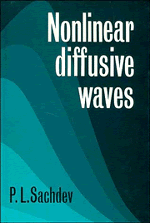1 - Introduction and overview
Published online by Cambridge University Press: 01 October 2009
Summary
Waves are ubiquitous in nature. They have been studied in the last couple of decades in such diverse forms and varied fields that they may now be said to constitute a new discipline — the science of waves (Lighthill, 1978). This wide and varied interest in waves has been particularly helped by the appearance of that strange entity, the soliton. The wave adopts such diverse forms that it is difficult to present a precise unifying definition. However, we may agree that waves (or disturbances), in an otherwise quiet or uniformly moving medium, have propagation properties and therefore involve the variable time, and have distinct features such as crests and troughs which themselves move with definite speeds. It should, however, be noted that not all waves are oscillatory. Thus, shock waves and solitary waves are not oscillatory. Nevertheless, these are regarded as (nonlinear) entities of great physical importance.
Two major types of waves have been distinguished (Whitham, 1974). The first is called hyperbolic and requires the system of n governing partial differential equations to have n real characteristic directions and correspondingly n linearly independent left eigenvectors of the relevant matrix (Courant & Hilbert, 1962). The second type of waves, called dispersive, are categorised by a real dispersion relation connecting the frequency and wave number (Bhatnagar, 1979). These definitions are broadened suitably to apply to partial differential equations with variable coefficients as well as nonlinear ones.
- Type
- Chapter
- Information
- Nonlinear Diffusive Waves , pp. 1 - 5Publisher: Cambridge University PressPrint publication year: 1987

